2015 FIAT 500L LIVING transmission
[x] Cancel search: transmissionPage 67 of 224
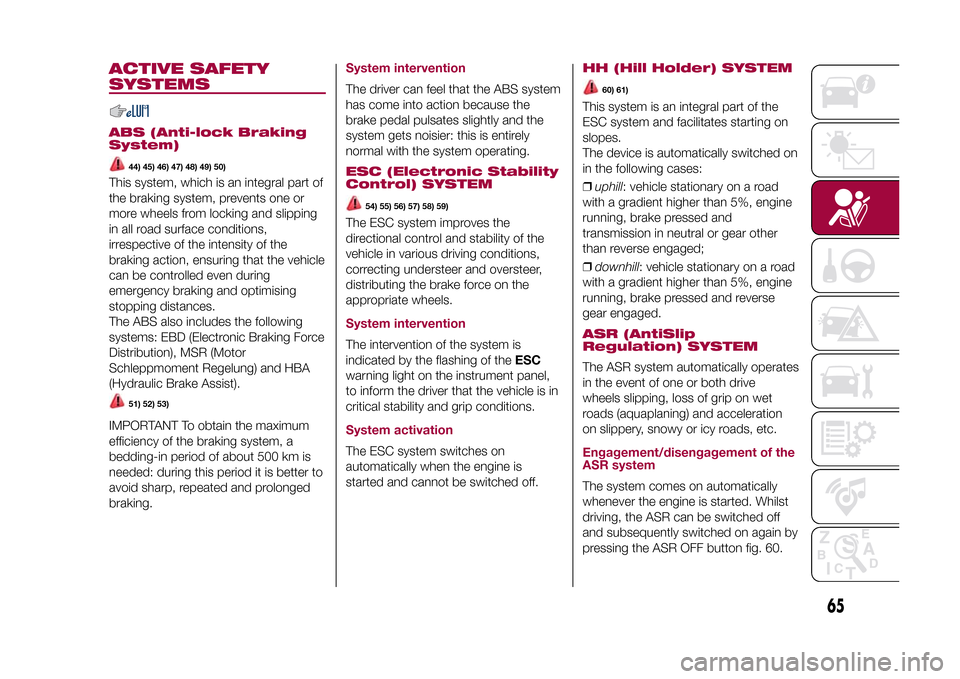
ACTIVE SAFETY
SYSTEMSABS (Anti-lock Braking
System)
44) 45) 46) 47) 48) 49) 50)
This system, which is an integral part of
the braking system, prevents one or
more wheels from locking and slipping
in all road surface conditions,
irrespective of the intensity of the
braking action, ensuring that the vehicle
can be controlled even during
emergency braking and optimising
stopping distances.
The ABS also includes the following
systems: EBD (Electronic Braking Force
Distribution), MSR (Motor
Schleppmoment Regelung) and HBA
(Hydraulic Brake Assist).
51) 52) 53)
IMPORTANT To obtain the maximum
efficiency of the braking system, a
bedding-in period of about 500 km is
needed: during this period it is better to
avoid sharp, repeated and prolonged
braking.
System interventionThe driver can feel that the ABS system
has come into action because the
brake pedal pulsates slightly and the
system gets noisier: this is entirely
normal with the system operating.ESC (Electronic Stability
Control) SYSTEM
54) 55) 56) 57) 58) 59)
The ESC system improves the
directional control and stability of the
vehicle in various driving conditions,
correcting understeer and oversteer,
distributing the brake force on the
appropriate wheels.System interventionThe intervention of the system is
indicated by the flashing of theESC
warning light on the instrument panel,
to inform the driver that the vehicle is in
critical stability and grip conditions.System activationThe ESC system switches on
automatically when the engine is
started and cannot be switched off.
HH (Hill Holder) SYSTEM
60) 61)
This system is an integral part of the
ESC system and facilitates starting on
slopes.
The device is automatically switched on
in the following cases:
❒uphill: vehicle stationary on a road
with a gradient higher than 5%, engine
running, brake pressed and
transmission in neutral or gear other
than reverse engaged;
❒downhill: vehicle stationary on a road
with a gradient higher than 5%, engine
running, brake pressed and reverse
gear engaged.ASR (AntiSlip
Regulation) SYSTEMThe ASR system automatically operates
in the event of one or both drive
wheels slipping, loss of grip on wet
roads (aquaplaning) and acceleration
on slippery, snowy or icy roads, etc.Engagement/disengagement of the
ASR systemThe system comes on automatically
whenever the engine is started. Whilst
driving, the ASR can be switched off
and subsequently switched on again by
pressing the ASR OFF button fig. 60.
65
9-1-2015 12:9 Pagina 65
Page 70 of 224
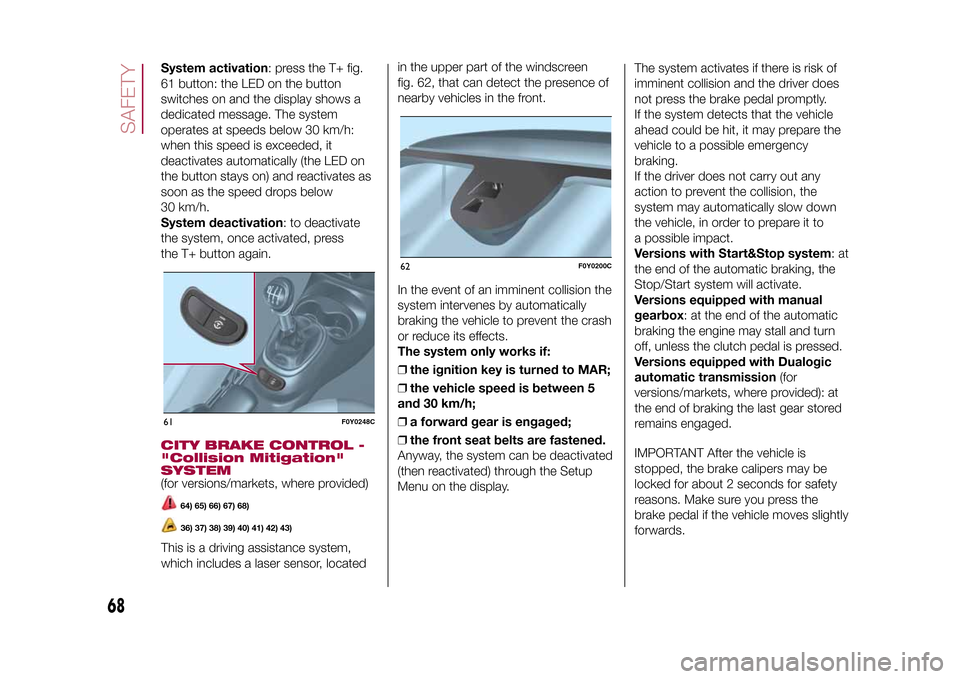
System activation: press the T+ fig.
61 button: the LED on the button
switches on and the display shows a
dedicated message. The system
operates at speeds below 30 km/h:
when this speed is exceeded, it
deactivates automatically (the LED on
the button stays on) and reactivates as
soon as the speed drops below
30 km/h.
System deactivation: to deactivate
the system, once activated, press
the T+ button again.CITY BRAKE CONTROL -
"Collision Mitigation"
SYSTEM(for versions/markets, where provided)
64) 65) 66) 67) 68)36) 37) 38) 39) 40) 41) 42) 43)
This is a driving assistance system,
which includes a laser sensor, locatedin the upper part of the windscreen
fig. 62, that can detect the presence of
nearby vehicles in the front.
In the event of an imminent collision the
system intervenes by automatically
braking the vehicle to prevent the crash
or reduce its effects.
The system only works if:
❒the ignition key is turned to MAR;
❒the vehicle speed is between 5
and 30 km/h;
❒a forward gear is engaged;
❒the front seat belts are fastened.
Anyway, the system can be deactivated
(then reactivated) through the Setup
Menu on the display.The system activates if there is risk of
imminent collision and the driver does
not press the brake pedal promptly.
If the system detects that the vehicle
ahead could be hit, it may prepare the
vehicle to a possible emergency
braking.
If the driver does not carry out any
action to prevent the collision, the
system may automatically slow down
the vehicle, in order to prepare it to
a possible impact.
Versions with Start&Stop system:at
the end of the automatic braking, the
Stop/Start system will activate.
Versions equipped with manual
gearbox: at the end of the automatic
braking the engine may stall and turn
off, unless the clutch pedal is pressed.
Versions equipped with Dualogic
automatic transmission(for
versions/markets, where provided): at
the end of braking the last gear stored
remains engaged.
IMPORTANT After the vehicle is
stopped, the brake calipers may be
locked for about 2 seconds for safety
reasons. Make sure you press the
brake pedal if the vehicle moves slightly
forwards.61
F0Y0248C
62
F0Y0200C
68
SAFETY
9-1-2015 12:9 Pagina 68
Page 98 of 224
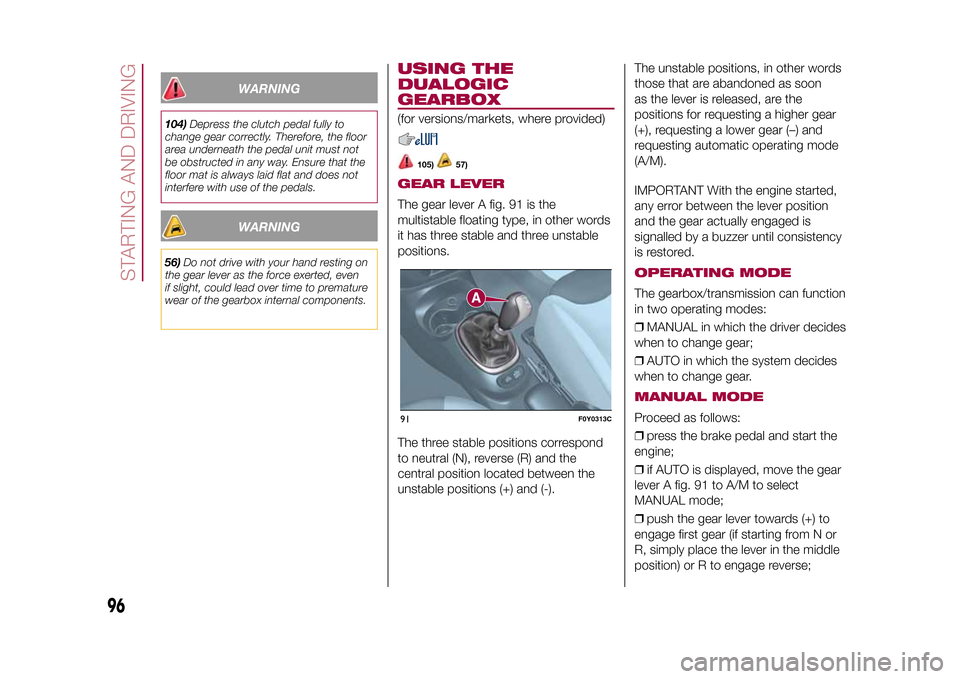
WARNING
104)Depress the clutch pedal fully to
change gear correctly. Therefore, the floor
area underneath the pedal unit must not
be obstructed in any way. Ensure that the
floor mat is always laid flat and does not
interfere with use of the pedals.
WARNING
56)Do not drive with your hand resting on
the gear lever as the force exerted, even
if slight, could lead over time to premature
wear of the gearbox internal components.
USING THE
DUALOGIC
GEARBOX(for versions/markets, where provided)
105)
57)
GEAR LEVERThe gear lever A fig. 91 is the
multistable floating type, in other words
it has three stable and three unstable
positions.
The three stable positions correspond
to neutral (N), reverse (R) and the
central position located between the
unstable positions (+) and (-).The unstable positions, in other words
those that are abandoned as soon
as the lever is released, are the
positions for requesting a higher gear
(+), requesting a lower gear (–) and
requesting automatic operating mode
(A/M).
IMPORTANT With the engine started,
any error between the lever position
and the gear actually engaged is
signalled by a buzzer until consistency
is restored.
OPERATING MODEThe gearbox/transmission can function
in two operating modes:
❒MANUAL in which the driver decides
when to change gear;
❒AUTO in which the system decides
when to change gear.MANUAL MODEProceed as follows:
❒press the brake pedal and start the
engine;
❒if AUTO is displayed, move the gear
lever A fig. 91 to A/M to select
MANUAL mode;
❒push the gear lever towards (+) to
engage first gear (if starting from N or
R, simply place the lever in the middle
position) or R to engage reverse;
91
F0Y0313C
96
STARTING AND DRIVING
9-1-2015 12:9 Pagina 96
Page 135 of 224

SCHEDULED
SERVICINGCorrect servicing is crucial for
guaranteeing a long life for the vehicle
under the best conditions. For this
reason, Fiat has planned a series of
checks and services at fixed distance
intervals and, where provided, at fixed
time intervals, as described in the
Scheduled Servicing Plan.
Before each service, it is always
necessary to carefully follow the
instructions in the Scheduled Servicing
Plan (e.g. periodically check level of
fluids, tyre pressure, etc.).
Scheduled Servicing is offered by all
Fiat Dealerships according to a set time
schedule. If, during each operation, in
addition to the ones scheduled, the
need arises for further replacements or
repairs, these may be carried out with
the owner's explicit agreement only.
If your vehicle is used frequently for
towing, the interval between one
service operation and the next should
be reduced.IMPORTANT Scheduled Servicing
interventions are set out by the
Manufacturer. Failure to have them
carried out may invalidate the warranty.
It is advisable to inform a Fiat
Dealership of any small operating
irregularities without waiting for the next
service.
PERIODIC CHECKSEvery1,000km or before long
journeys, check and if necessary, top
up: engine coolant level; brake fluid
level; screen washer fluid level; tyre
inflation pressure and condition; lighting
system operation (headlights, direction
indicators, hazard warning lights, etc.);
screen washer/wiper system operation
and positioning/wear of windscreen/
rear window wiper blades.
Every3,000km, check and top up if
required: engine oil level.HEAVY-DUTY USE OF THE
VEHICLEIf the vehicle is used under one of the
following conditions:
❒towing a trailer or caravan;
❒dusty roads;
❒short, repeated journeys (less than
7-8 km) at sub-zero outside
temperatures;❒engine often idling or driving long
distances at low speeds or long periods
of inactivity;
the following checks must be carried
out more often than indicated in the
Scheduled Servicing Plan:
❒check front disc brake pad condition
and wear;
❒check cleanliness of bonnet and
luggage compartment locks,
cleanliness and lubrication of linkage;
❒visually inspect conditions of: engine,
gearbox, transmission, pipes and
hoses (exhaust/fuel system/brakes) and
rubber elements (gaiters/sleeves/
bushes, etc.);
❒check battery charge and battery
fluid level (electrolyte);
❒visually inspect conditions of the
accessory drive belts;
❒check and, if necessary, change
engine oil and replace oil filter;
❒check and, if necessary, replace
pollen filter;
❒check and, if necessary, replace air
cleaner.
133
9-1-2015 12:9 Pagina 133
Page 154 of 224
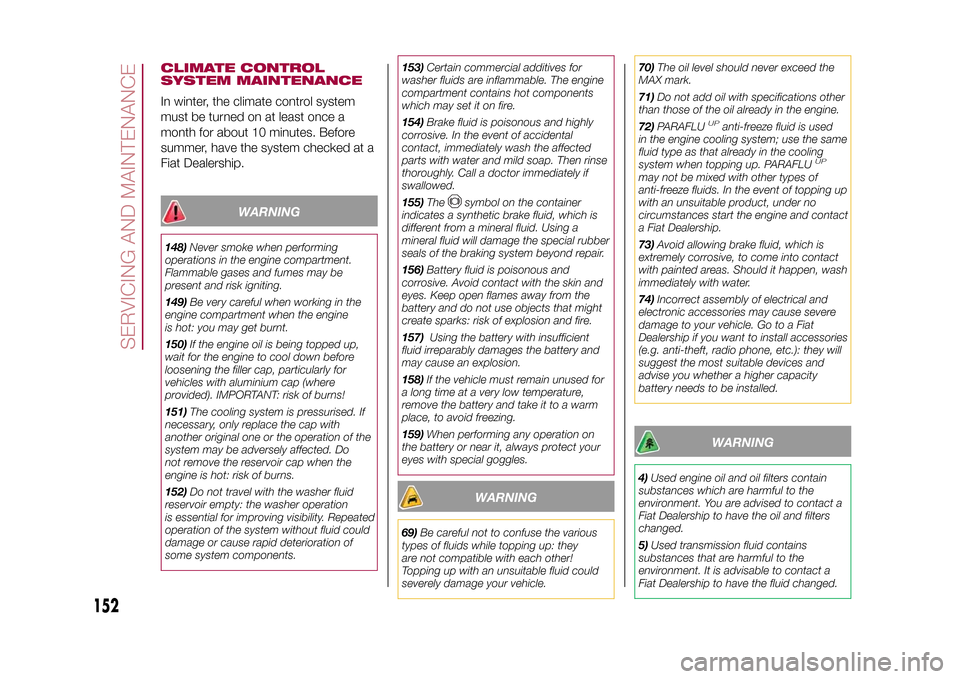
CLIMATE CONTROL
SYSTEM MAINTENANCEIn winter, the climate control system
must be turned on at least once a
month for about 10 minutes. Before
summer, have the system checked at a
Fiat Dealership.
WARNING
148)Never smoke when performing
operations in the engine compartment.
Flammable gases and fumes may be
present and risk igniting.
149)Be very careful when working in the
engine compartment when the engine
is hot: you may get burnt.
150)If the engine oil is being topped up,
wait for the engine to cool down before
loosening the filler cap, particularly for
vehicles with aluminium cap (where
provided). IMPORTANT: risk of burns!
151)The cooling system is pressurised. If
necessary, only replace the cap with
another original one or the operation of the
system may be adversely affected. Do
not remove the reservoir cap when the
engine is hot: risk of burns.
152)Do not travel with the washer fluid
reservoir empty: the washer operation
is essential for improving visibility. Repeated
operation of the system without fluid could
damage or cause rapid deterioration of
some system components.153)Certain commercial additives for
washer fluids are inflammable. The engine
compartment contains hot components
which may set it on fire.
154)Brake fluid is poisonous and highly
corrosive. In the event of accidental
contact, immediately wash the affected
parts with water and mild soap. Then rinse
thoroughly. Call a doctor immediately if
swallowed.
155)The
symbol on the container
indicates a synthetic brake fluid, which is
different from a mineral fluid. Using a
mineral fluid will damage the special rubber
seals of the braking system beyond repair.
156)Battery fluid is poisonous and
corrosive. Avoid contact with the skin and
eyes. Keep open flames away from the
battery and do not use objects that might
create sparks: risk of explosion and fire.
157)Using the battery with insufficient
fluid irreparably damages the battery and
may cause an explosion.
158)If the vehicle must remain unused for
a long time at a very low temperature,
remove the battery and take it to a warm
place, to avoid freezing.
159)When performing any operation on
the battery or near it, always protect your
eyes with special goggles.WARNING
69)Be careful not to confuse the various
types of fluids while topping up: they
are not compatible with each other!
Topping up with an unsuitable fluid could
severely damage your vehicle.70)The oil level should never exceed the
MAX mark.
71)Do not add oil with specifications other
than those of the oil already in the engine.
72)PARAFLU
UP
anti-freeze fluid is used
in the engine cooling system; use the same
fluid type as that already in the cooling
system when topping up. PARAFLU
UP
may not be mixed with other types of
anti-freeze fluids. In the event of topping up
with an unsuitable product, under no
circumstances start the engine and contact
a Fiat Dealership.
73)Avoid allowing brake fluid, which is
extremely corrosive, to come into contact
with painted areas. Should it happen, wash
immediately with water.
74)Incorrect assembly of electrical and
electronic accessories may cause severe
damage to your vehicle. Go to a Fiat
Dealership if you want to install accessories
(e.g. anti-theft, radio phone, etc.): they will
suggest the most suitable devices and
advise you whether a higher capacity
battery needs to be installed.
WARNING
4)Used engine oil and oil filters contain
substances which are harmful to the
environment. You are advised to contact a
Fiat Dealership to have the oil and filters
changed.
5)Used transmission fluid contains
substances that are harmful to the
environment. It is advisable to contact a
Fiat Dealership to have the fluid changed.
152
SERVICING AND MAINTENANCE
9-1-2015 12:9 Pagina 152
Page 183 of 224
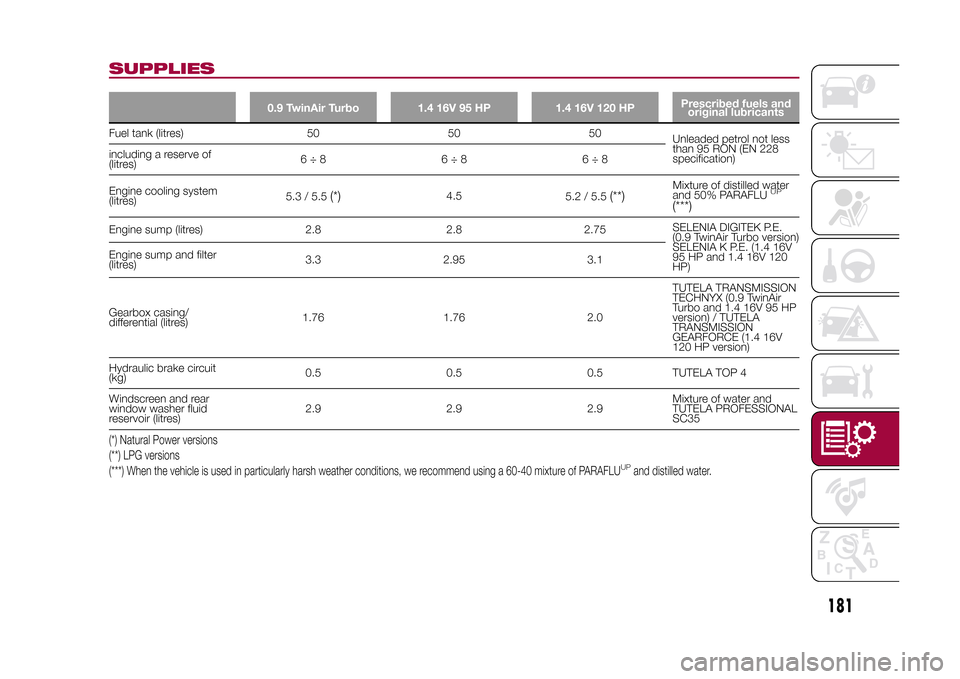
SUPPLIES
0.9 TwinAir Turbo 1.4 16V 95 HP 1.4 16V 120 HPPrescribed fuels and
original lubricants
Fuel tank (litres) 50 50 50
Unleaded petrol not less
than 95 RON (EN 228
specification) including a reserve of
(litres)6÷8 6÷8 6÷8
Engine cooling system
(litres)5.3 / 5.5
(*)
4.5
5.2 / 5.5
(**)
Mixture of distilled water
and 50% PARAFLU
UP
(***)
Engine sump (litres) 2.8 2.8 2.75SELENIA DIGITEK P.E.
(0.9 TwinAir Turbo version)
SELENIA K P.E. (1.4 16V
95 HP and 1.4 16V 120
HP) Engine sump and filter
(litres)3.3 2.95 3.1
Gearbox casing/
differential (litres)1.76 1.76 2.0TUTELA TRANSMISSION
TECHNYX (0.9 TwinAir
Turbo and 1.4 16V 95 HP
version) / TUTELA
TRANSMISSION
GEARFORCE (1.4 16V
120 HP version)
Hydraulic brake circuit
(kg)0.5 0.5 0.5 TUTELA TOP 4
Windscreen and rear
window washer fluid
reservoir (litres)2.9 2.9 2.9Mixture of water and
TUTELA PROFESSIONAL
SC35(*) Natural Power versions
(**) LPG versions
(***) When the vehicle is used in particularly harsh weather conditions, we recommend using a 60-40 mixture of PARAFLU
UP
and distilled water.
181
9-1-2015 12:9 Pagina 181
Page 184 of 224
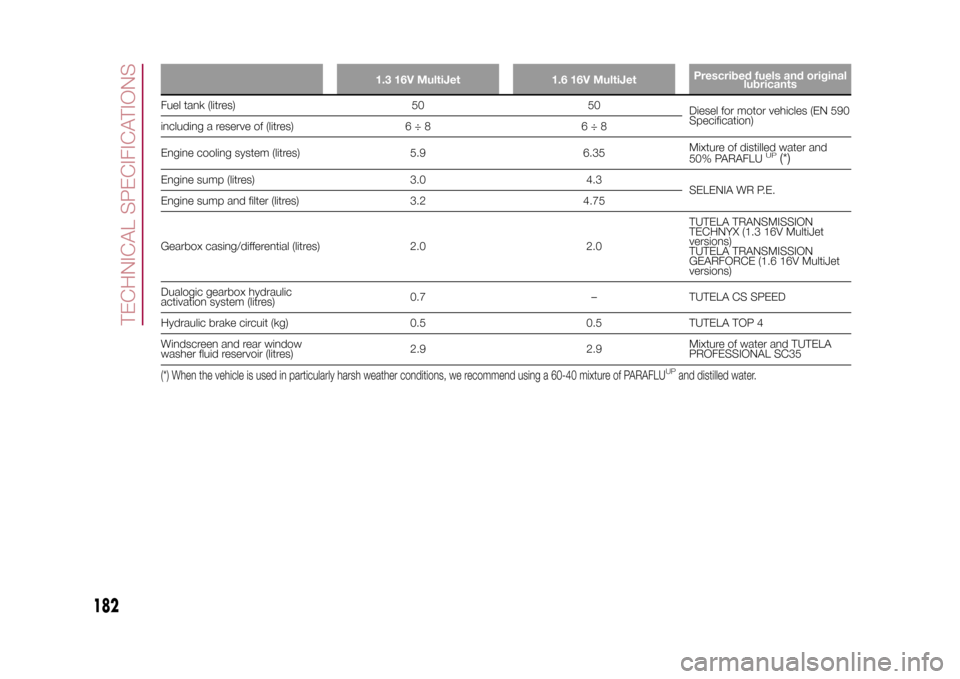
1.3 16V MultiJet 1.6 16V MultiJetPrescribed fuels and original
lubricants
Fuel tank (litres) 50 50
Diesel for motor vehicles (EN 590
Specification)
including a reserve of (litres) 6 ÷ 8 6 ÷ 8
Engine cooling system (litres) 5.9 6.35Mixture of distilled water and
50% PARAFLU
UP
(*)
Engine sump (litres) 3.0 4.3
SELENIA WR P.E.
Engine sump and filter (litres) 3.2 4.75
Gearbox casing/differential (litres) 2.0 2.0TUTELA TRANSMISSION
TECHNYX (1.3 16V MultiJet
versions)
TUTELA TRANSMISSION
GEARFORCE (1.6 16V MultiJet
versions)
Dualogic gearbox hydraulic
activation system (litres)0.7 – TUTELA CS SPEED
Hydraulic brake circuit (kg) 0.5 0.5 TUTELA TOP 4
Windscreen and rear window
washer fluid reservoir (litres)2.9 2.9Mixture of water and TUTELA
PROFESSIONAL SC35(*) When the vehicle is used in particularly harsh weather conditions, we recommend using a 60-40 mixture of PARAFLU
UP
and distilled water.
182
TECHNICAL SPECIFICATIONS
9-1-2015 12:9 Pagina 182
Page 186 of 224
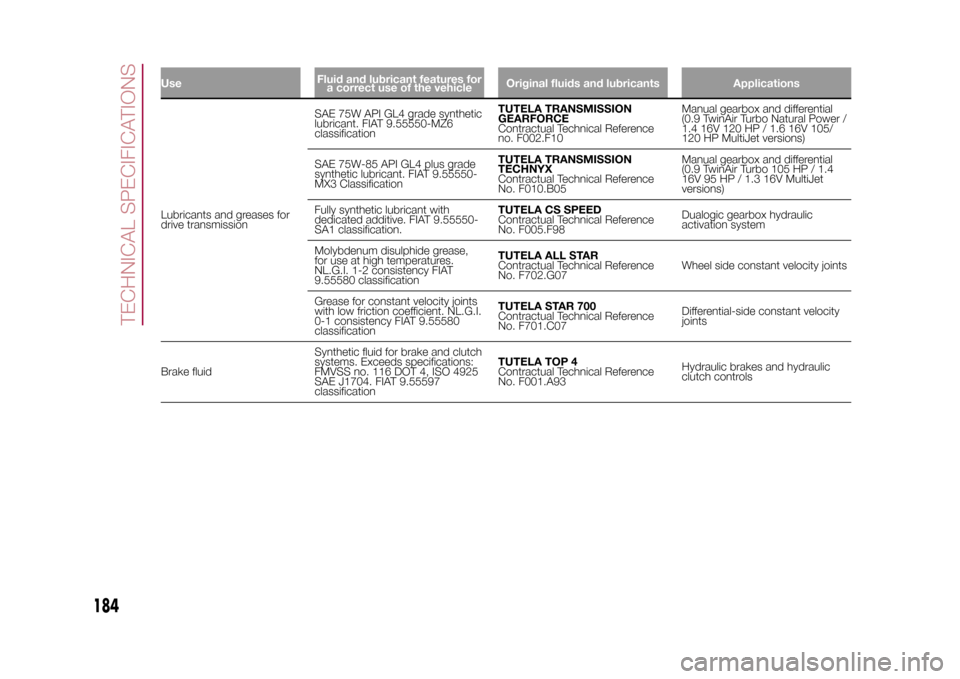
UseFluid and lubricant features for
a correct use of the vehicleOriginal fluids and lubricants ApplicationsLubricants and greases for
drive transmissionSAE 75W API GL4 grade synthetic
lubricant. FIAT 9.55550-MZ6
classificationTUTELA TRANSMISSION
GEARFORCE
Contractual Technical Reference
no. F002.F10Manual gearbox and differential
(0.9 TwinAir Turbo Natural Power /
1.4 16V 120 HP / 1.6 16V 105/
120 HP MultiJet versions)
SAE 75W-85 API GL4 plus grade
synthetic lubricant. FIAT 9.55550-
MX3 ClassificationTUTELA TRANSMISSION
TECHNYX
Contractual Technical Reference
No. F010.B05Manual gearbox and differential
(0.9 TwinAir Turbo 105 HP / 1.4
16V 95 HP / 1.3 16V MultiJet
versions)
Fully synthetic lubricant with
dedicated additive. FIAT 9.55550-
SA1 classification.TUTELA CS SPEED
Contractual Technical Reference
No. F005.F98Dualogic gearbox hydraulic
activation system
Molybdenum disulphide grease,
for use at high temperatures.
NL.G.I. 1-2 consistency FIAT
9.55580 classificationTUTELA ALL STAR
Contractual Technical Reference
No. F702.G07Wheel side constant velocity joints
Grease for constant velocity joints
with low friction coefficient. NL.G.I.
0-1 consistency FIAT 9.55580
classificationTUTELA STAR 700
Contractual Technical Reference
No. F701.C07Differential-side constant velocity
joints
Brake fluidSynthetic fluid for brake and clutch
systems. Exceeds specifications:
FMVSS no. 116 DOT 4, ISO 4925
SAE J1704. FIAT 9.55597
classificationTUTELA TOP 4
Contractual Technical Reference
No. F001.A93Hydraulic brakes and hydraulic
clutch controls
184
TECHNICAL SPECIFICATIONS
9-1-2015 12:9 Pagina 184